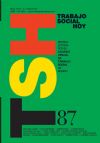Factor exploratorio de la estructura de la intención de emigrar
[Exploratory factor structure of the intention to emigrate]
Autoría: Carreón-Guillén,Javier(1);Quintero-Soto,María Luisa(2);Molina-Ruíz, Héctor Daniel(3),Hernández-Valdés,Jorge(1);García-Lirios,Cruz(2)
Datos profesionales del autor/a: (1)Universidad Nacional Autónoma de México
(2)Universidad Autónoma del Estado de México
(3)Universidad Autónoma del Estado de Hidalgo
(2)Universidad Autónoma del Estado de México
(3)Universidad Autónoma del Estado de Hidalgo
Correspondencia: Javier Carreón-Guillén. Universidad Nacional Autónoma de México. María Luisa Quintero-Soto. Universidad Autónoma del Estado de México. Héctor Daniel Molina-Ruíz. Universidad Autónoma del Estado de Hidalgo. Jorge Hernández-Valdés. Universidad Nacional Autónoma de México. Cruz García-Lirios. Universidad Autónoma del Estado de México. Email: javierg@unam.mx
Recibido: 5/2/2019
Revisado: 22/4/2019
Aceptado: 21/5/2019
Publicado: 31/5/2019
Resumen
La exploración de las dimensiones intencionales de la migración fue el objetivo de este trabajo. Se realizó un estudio no experimental con una selección no probabilística de 300 estudiantes de secundaria. Se estimó una matriz factorial que explicaba el 32 % de la varianza total y se observó un modelo estructural en el que prevalecen cuatro dimensiones que reflejan 16 indicadores, pero el diseño de la investigación limita los hallazgos, lo que sugiere la extensión del trabajo y la inclusión de otros factores: expectativas, emprendimiento, selectividad y competitividad.
Descarga del artículo:
Palabras Clave
Migración, Identidad, Hipermetropía, Desamparo, Fiabilidad.
Abstract
The exploration of the intentional dimensions of migration was the objective of this work. A non-experimental study was carried out with a non-probabilistic selection of 300 high school students. A factorial matrix was estimated that explained 32 % of the total variance and a structural model was observed in which four dimensions that reflect 16 indicators prevail, but the research design limits the findings, suggesting the extension of the work and the inclusion of other factors such as expectations, entrepreneurship, selectivity and competitiveness.
Key Words
Migration, Identity, Hyperopia, Helplessness, Reliability.
Referencia Normalizada (cómo citar este artículo)
Javier Carreón-Guillén, J., Quintero-Soto. M.L., Molina-Ruíz, H.D., Hernández-Valdés, J., y Cruz García-Lirios, C. (2019). Universidad Autónoma del Estado de México (2019). Exploratory factor structure of the intention to emigrate. Trabajo Social Hoy, 87, 57-64. doi: 10.12960/TSH.2019.0011
Texto del Artículo
Referencias
Alberti, AV (2012). A theoretical reflection on labor migration, through the historical case of the braceros program (1942-1964). Nomads, Special Issue of Latin America, 1-15.
Busso, MP. (2016). The migration of Argentines in the graphic press and Internet forums: The differentiated construction of identification groups. Gallaxia, 33, 20-31 http://dx.doi.org/10.1590/1982-255420162278112
Carreón, J. (2016). Human development: Governance and social entrepreneurship. Mexico: UNAM-ENTS
Carreón, J., Hernández, J., Morales, ML, García, C. and Bustos, JM (2014). Contrast a model of social reliability based on emotions related to public safety. Psicumex, 4 (2), 44-70
Delgado, MA, García, C. and Mejía, S. (2018). Specification of a model for the study of consensual migration. Ehquidad, 9, 33-49
Ferrer, R., Palacio, J., Hoyos, O. and Madariaga, C. (2014). Acculturation process and adaptation of the migrant: Individual characteristics and social networks. Psychology from the Caribbean, 31 (3), 557-576.
García, C. (2013). Immigrant insecurity in print media. Reflections 92, 159-173.
García, C. (2014). Specification of a social entrepreneurship model. Reason and Word, 88 (51), 1-50 http://www.razonypalabra.org.mx/N/N88/Varia/51_Garcia_V88.pdf
García, C. (2017a). Specification of a model for the study of labor interculturalism. Perspectives, 30, 83-109 http://ediciones.ucsh.cl/ojs/index.php/Perspectivas/article/view/1523/1270
García, C. (2017b). Model of intercultural migratory occupational health. Science and Humanism in Health, 4 (2), 61-68http://revista.medicina.uady.mx/revista/index.php/cienciayhumanismo/issue/view/14
García, C. (2018). Entrepreneurship of coffee farmers in migrants from the Huaztec region of central Mexico. Equity & Development, 30, 119-147 http://dx.doi.org/10.19052/ed.4324
García, C., Carreón, J., Hernández, J., Bustos, J. and Aguilar, J. (2015). Specification of a sociopolitical farsightedness model. Luna Azul, 42, 270-292
Pardo AM and Dávila, CA (2017). Migration and development: Characteristics of households and use of internal remittances. Development and Society, 78, 113-141
Paredes, MT, Tovar, LM, Ospina, JA, Tovar, DA, Andrade, M. (2016), international migration and living conditions: Exploring the Colombian case. Migrations, 40, 53-81 http://dx.doi.org/mig.i40.y2016.013
Sánchez, A., Juárez, M., Bustos, JM and García, C. (2018). Contrast of a model and labor expectations in ex-migrants from the center of Mexico. Management of People and Technology, 32, 21-36
Valdés, O., Quintero, ML and García, C. (2017). Complexity of a migrant labor culture model. Doxa, 7 (13), 66-78 http://journals.sfu.ca/doxa/index.php/doxa/article/view/39/29
Busso, MP. (2016). The migration of Argentines in the graphic press and Internet forums: The differentiated construction of identification groups. Gallaxia, 33, 20-31 http://dx.doi.org/10.1590/1982-255420162278112
Carreón, J. (2016). Human development: Governance and social entrepreneurship. Mexico: UNAM-ENTS
Carreón, J., Hernández, J., Morales, ML, García, C. and Bustos, JM (2014). Contrast a model of social reliability based on emotions related to public safety. Psicumex, 4 (2), 44-70
Delgado, MA, García, C. and Mejía, S. (2018). Specification of a model for the study of consensual migration. Ehquidad, 9, 33-49
Ferrer, R., Palacio, J., Hoyos, O. and Madariaga, C. (2014). Acculturation process and adaptation of the migrant: Individual characteristics and social networks. Psychology from the Caribbean, 31 (3), 557-576.
García, C. (2013). Immigrant insecurity in print media. Reflections 92, 159-173.
García, C. (2014). Specification of a social entrepreneurship model. Reason and Word, 88 (51), 1-50 http://www.razonypalabra.org.mx/N/N88/Varia/51_Garcia_V88.pdf
García, C. (2017a). Specification of a model for the study of labor interculturalism. Perspectives, 30, 83-109 http://ediciones.ucsh.cl/ojs/index.php/Perspectivas/article/view/1523/1270
García, C. (2017b). Model of intercultural migratory occupational health. Science and Humanism in Health, 4 (2), 61-68http://revista.medicina.uady.mx/revista/index.php/cienciayhumanismo/issue/view/14
García, C. (2018). Entrepreneurship of coffee farmers in migrants from the Huaztec region of central Mexico. Equity & Development, 30, 119-147 http://dx.doi.org/10.19052/ed.4324
García, C., Carreón, J., Hernández, J., Bustos, J. and Aguilar, J. (2015). Specification of a sociopolitical farsightedness model. Luna Azul, 42, 270-292
Pardo AM and Dávila, CA (2017). Migration and development: Characteristics of households and use of internal remittances. Development and Society, 78, 113-141
Paredes, MT, Tovar, LM, Ospina, JA, Tovar, DA, Andrade, M. (2016), international migration and living conditions: Exploring the Colombian case. Migrations, 40, 53-81 http://dx.doi.org/mig.i40.y2016.013
Sánchez, A., Juárez, M., Bustos, JM and García, C. (2018). Contrast of a model and labor expectations in ex-migrants from the center of Mexico. Management of People and Technology, 32, 21-36
Valdés, O., Quintero, ML and García, C. (2017). Complexity of a migrant labor culture model. Doxa, 7 (13), 66-78 http://journals.sfu.ca/doxa/index.php/doxa/article/view/39/29





